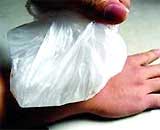When experiencing sprains, dislocations, or muscle bruises, don’t forget to apply cold compresses. This therapy helps reduce pain and swelling by increasing the threshold of stimulation of muscle fibers, causing vasoconstriction and reducing blood flow to the injured area.
 In daily activities such as work, play, and exercise, individuals can suffer accidents resulting in various injuries like sprains, dislocations, muscle bruises, fractures, electric shocks, and burns. For on-site first aid, basic techniques include bandaging, bleeding control, immobilization, transportation, and artificial respiration depending on the type of injury. However, in many cases, people forget to utilize cold therapy.
In daily activities such as work, play, and exercise, individuals can suffer accidents resulting in various injuries like sprains, dislocations, muscle bruises, fractures, electric shocks, and burns. For on-site first aid, basic techniques include bandaging, bleeding control, immobilization, transportation, and artificial respiration depending on the type of injury. However, in many cases, people forget to utilize cold therapy.
For common injuries like sprains, muscle bruises, muscle tears, and moderate to mild ligament strains, self-treatment at home can be effective, especially with cold compresses. When experiencing these injuries, depending on the severity, the injured area should be kept completely still for the first 24-72 hours to apply methods such as cold compresses, immobilization, and elevation.
Applying cold compresses to the injured area serves as an independent method within the general treatment process for injuries, particularly sports injuries. This simple yet highly effective method significantly alleviates pain and swelling. Cold compresses increase the threshold of stimulation of muscle fibers, induce vasoconstriction, and reduce blood flow to the injured area, leading to decreased swelling and pain. Cold therapy diminishes muscle spasms, resulting in improved circulation and reduced metabolic disturbances in the injured area.
For maximum effectiveness, cold compresses should be applied immediately in the first moments after an injury. During the first 48-72 hours, cold compresses should be applied frequently. Each session should last 15-20 minutes, with a break of 120-180 minutes in between (during the first 24 hours, the breaks should be around 30-60 minutes). Depending on the severity of the injury, cold therapy may continue until the seventh day post-injury, gradually decreasing in frequency.
For mild injuries with minimal swelling and bleeding, applying cold compresses for the first 24-48 hours is sufficient. Each session should last around 10-15 minutes, depending on the type of injury and the depth of the affected area.
The cold compress technique is carried out as follows: Use ice or crushed ice wrapped in plastic or a damp cloth (the ice temperature should be around 0-3 degrees Celsius). A neutral cream or petroleum jelly should be applied to the area to prevent cold-induced damage. Gently apply the ice pack to the surface of the skin in the injured area, rubbing lightly in concentric circles for 5-10 minutes, depending on the anatomical characteristics of the affected area.
The typical sensations when using this method are that the treated area feels cold, then sharp pain, and finally a numbness sensation.
Avoid movements that cause pain, as pain can lead to spasms. The injured area should be kept as relaxed as possible to facilitate the recovery process.
At this stage, cold therapy should be combined with the following measures:
Compression Bandaging: Use cloth or elastic bandages to compress the injured area firmly enough to reduce swelling and provide stable support for the injured muscles and joints. Compress the area during cold therapy by bandaging over the ice pack and continue bandaging between cold sessions.
Elevation: The injured area should be kept elevated to avoid blood pooling and limit swelling. Depending on the injured area, an appropriate elevated position should be maintained to not hinder daily activities. If conditions allow, the injured area should be raised above heart level.
Important Considerations
In the first 72 hours post-injury, do not apply any methods or substances (including hot baths) that heat the injured area, avoid using ointments, and do not massage the injured area or consume alcohol. All these actions may increase swelling and bleeding in the injured area.
The self-treatment protocol mentioned above is only applicable in the initial phase of treatment or first aid. Depending on the nature and severity of the injury, it is advisable to see a doctor as soon as possible. If, within 24-48 hours of using the above self-treatment methods, symptoms of injury to muscles, tendons, joints, or ligaments (pain, swelling) do not improve, or worsen, please consult a doctor.
While following this self-treatment protocol, pain-relieving anti-inflammatory medications (such as aspirin or ibuprofen) may be used depending on the condition of the injury.
Dr. Dang Quoc Bao


















































